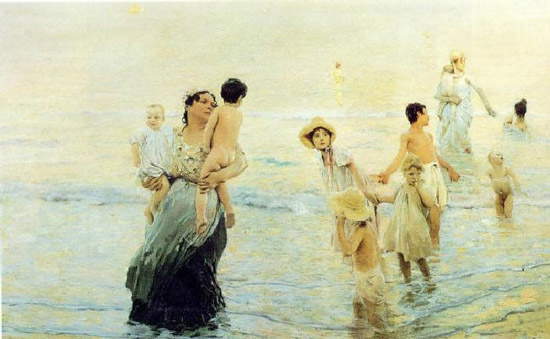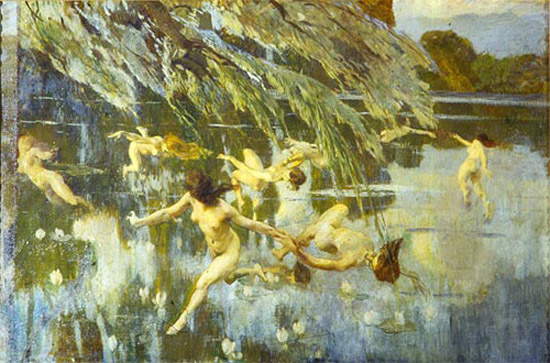When Ettore Tito (1859 - 1941) exhibited his marvelous work July, which had just been completed, at the 1894 Esposizioni Riunite in Milan, the writer Leone Fortis, who dedicated a book to those Expositions, described the painting as a “scene of bathing by the sea, full of light and effect.” Instead, the Illustrated Visitor’s Guide spoke of it this way: “the sea under the blazing sun, and the figures full of the reflections of the water, give the overall effect of the great diffused light; besides which the figures have a great rightness of form and movement-and the general color is warm and sympathetic.” The scene is, apparently, very simple: there is a large group of characters bathing in the sea. In the very foreground, a mother is getting two children out of the water. A little further back, a small group of young boys and children, together, are holding hands. Still further back, another mother is carrying her youngest child and holding hands with her oldest. The painting, which passed through several private collections, is now kept at the picture gallery of Villa Trissino Marzotto in Trissino, in the province of Vicenza, where the public can admire it.
 |
| Ettore Tito, July (1893-1894; Trissino, Villa Trissino Marzotto) |
If we were to point to three additional protagonists, besides the characters that crowd the painting, we would have to mention three: light, technique and the sea. The light, in Ettore Tito, is warm, enveloping, making not only the characters vibrate with vitality, whose richness of detail we also admire (just look at the dress of the woman in the foreground: the painter has impeccably rendered the wet parts), but even the ripples of a sea lapped by a gentle breeze, judging by the white froth forming on the surface. This realism, which never reached the levels of rawness of that of the painting of other painters of his contemporaries, but which, on the contrary, often exuded poeticity and tenderness, continued a centuries-old tradition, that of the great Venetian painting of which Ettore Tito was among the main exponents at the turn of the nineteenth and twentieth centuries, in spite of his Neapolitan origins: he was in fact born in Castellammare di Stabia, but had moved to Venice as a child, and there he had done all his studies and drawn all his inspirations. Art historians and critics have juxtaposed him now with Giambattista Tiepolo, now with Francesco Guardi, now with Paolo Veronese. They have wanted to see in Ettore Tito a kind of continuer of Tiepolo’s freedom and lightness: some of his frescoes show very clear suggestions drawn from Tiepolo’s art, and on one occasion, in 1917, he even found himself having to replace a destroyed fresco by the illustrious 18th-century painter. But in Tito one can also see again the muffled atmospheres of Guardi, as well as the generous bodies and vivid colorism of Veronese: not by chance, Roberto Longhi called Ettore Tito “a Paolo Veronese with Kodak.”
Indeed, we have said that the second protagonist of the Villa Trissino Marzotto painting, as well as of a great many other paintings by Ettore Tito, is the technique, which we can almost consider borrowed from photography: typically photographic is the use of arranging some figures, very large, very close to the observer, almost attached to the lower edge of the composition, gradually distancing all the other characters. And what we see in July is not even one of the most daring shots: there are paintings, such as On the Lagoon of 1897, one of his most famous works, preserved in Venice at Ca’ Pesaro, in which the two protagonists, the gondolier and the girl being transported on the gondola, are so close to us that it almost seems as if the painter has also placed himself on the gondola, in front of the girl, and there created the painting. And, of course, part of the gondola is cut off from the composition: a device, also typically photographic, to suggest the movement, the pacing of the boat on the water. Photography, after all, exerted a certain fascination on painters at the end of the nineteenth century, and undoubtedly Ettore Tito, too, was captivated by the new possibilities this medium offered artists: we do not know if he took photographs, because there is no evidence left to us in this regard, but he certainly knew its techniques, tricks, and framing.
 |
| Ettore Tito, On the Lagoon (1897; Venice, Ca’ Pesaro International Gallery of Modern Art) |
Finally, the sea, a constant and almost omnipresent element, also for geographical reasons, in Ettore Tito’s art. And even when it is not visible within the physical limits of the composition, its presence is often felt, one senses that a scene is set near the coast because the enveloping, dazzling light makes one perceive the proximity of the sea. It is near the sea, on a beach, that the story of Love Pages takes place, a work preserved in the Frugone Collections in Genoa, and which met with great success when it was exhibited for the first time, at the 1909 Venice Biennale. A tasty genre scene set under a pergola on the beach, where some women are listening to the reading of a love letter by one of them, who wears fiery red hair wrapped in a white veil, suggested by short, rapid brushstrokes on which, however, touches of color are laid to seek luministic effects, as somewhat throughout the painting. The light is the somewhat soft, gentle, cool, and grazing light of that particular moment when the day is about to give way to evening: the sun disappears casting its last glimmers, the shadows lengthen to turn then into a penumbra that will envelop the beach dampening the heat, and the sky is tinged with pink. The painting is evocative: one almost seems to perceive the silence of the beach interrupted only by the subdued sound of the surf, the rustling of robes moved by the wind, and the soft voice of the girl reading the letter. And perhaps of the shy laughter of the one who smiles resting her chin on the back of her hand.
 |
| Ettore Tito, Love Pages (1909; Genoa, Raccolte Frugone). |
Made in 1909, and also exhibited at the Venice Biennale, is another “aquatic” painting, set, however, in a river instead of at the sea: the work is The Bath and presents us with a girl, with graceful and sinuous forms, who is cooling herself under the branches of a tree, while vexatiously arranging her hair. Ettore Tito’s brush creates light effects on the water, which creates concentric circles around the legs of the young woman, immersed up to mid-calf, but above all he creates, again by means of light, a beautiful body, inspiring sensuality and love, reminiscent, as many also noted at the time, of the voluptuous nudes of Anders Zorn, but also bringing back to the Greek goddesses of antiquity: one should not overlook the influence that classical art also played on the poetics of the painter from Campania by birth but Veneto by adoption. It is not infrequent to come across mythological scenes in his production: nymphs playing on the shores of the sea, Venuses rising from the waves, sirens emerging from the waves.
 |
| Ettore Tito, The Bath (1909; Paris, Musée d’Orsay) |
 |
| Ettore Tito, The Bath, detail |
It is worth mentioning in this regard at least The Nymphs from the Ricci Oddi Gallery in Piacenza, exhibited at the 1912 Venice Biennale. In the same year in which the Futurist painters were beginning to show their work publicly, Ettore Tito remained firmly anchored in a terse, luminous figurative tradition that looked back to a happy past full of lofty experiences. It was a tradition that allowed him to set the dance of his nude and light nymphs in a landscape typical of the Venetian Lagoon, making the Veronese bodies of the nymphs stand out through the sunny luminosity of the lagoon, with the willows reflected on the water where the water lilies float. All combined with the lyricism that always seems to flow in the brushstrokes of one of the most poetic, evocative and evocative painters of his generation.
 |
| Ettore Tito, The Nymphs (1912; Piacenza, Galleria Ricci Oddi) |
Warning: the translation into English of the original Italian article was created using automatic tools. We undertake to review all articles, but we do not guarantee the total absence of inaccuracies in the translation due to the program. You can find the original by clicking on the ITA button. If you find any mistake,please contact us.